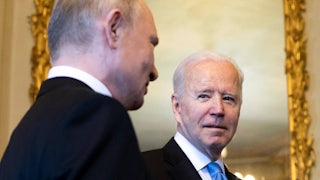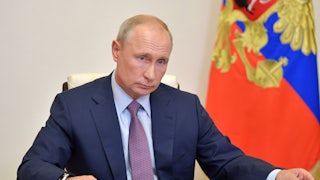One of the positive features of the post–Cold War world—aside from plummeting poverty rates and higher global life expectancies—has been the declining incidence of wars between nations. Quite simply, states rarely invade their neighbors and seize their territory.
But that only occasionally interrupted streak may soon be coming to an end. Along the Russia-Ukraine border, Moscow is amassing a strike force of approximately 175,000 troops and, according to U.S. intelligence officials, is planning a military offensive against its neighbor that will be launched early next year.
However, war is far from inevitable. And the fact that Russia is clearly telegraphing its plans offers compelling evidence that the military threat from Moscow is largely coercive. But the United States will need to figure out a way for all sides to avoid conflict—a process that began on Tuesday during a two-hour video chat between President Joe Biden and Russian President Vladimir Putin, which will hopefully lessen tensions in the region. But there is more work to be done, and it will begin with Biden making painful but necessary decisions about whether he cares more about stability with Russia or support for Ukraine.
Tensions between the Kremlin and Kyiv have been high since 2014. That year, Russia bloodlessly seized and annexed Crimea from Ukraine and began providing direct support to pro-Russian rebels in the Donbas region of Eastern Ukraine, who launched a bloody sectarian insurgency. While the current situation is the closest that the two sides have come to war since then, the potential for conflict has been brewing for years, particularly as Ukraine has moved closer to the West’s political and military orbit.
It wasn’t that long ago that Russia enjoyed a relatively close relationship with Ukraine and its pro-Russian president, Viktor Yanukovych. But when Yanukovych was ousted from power in 2014 during the Maidan Revolution, it hastened Kyiv’s steady move into the Western orbit—one accelerated by Moscow’s military aggression.
Indeed, as Rob Lee, a Ph.D. student at King’s College and a close observer of the Russian military, said to me, Moscow’s decision to seize Crimea and spark a separatist fight in Eastern Ukraine was intended to coerce Kyiv but is having the opposite effect. “Russia has pushed Ukraine into the arms of the West,” says Lee, who pointed out that Russia’s military actions since 2014—seizing Crimea and backing separatists in the Donbas—have removed the political participation of the country’s most pro-Russian voting regions, as people in the areas controlled by the separatists weren’t able to vote. As a result, support for NATO membership has dramatically grown in Ukraine and so, too, has the desire to break free from Moscow’s influence.
According to two recent polls, approximately 60 percent of Ukrainians are supportive of the country joining NATO. In 2014, the numbers were around 15 to 20 percent and, amazingly, Putin was considered the most popular politician in the country.
While the prospect of NATO membership for Ukraine remains Putin’s top concern, close behind is the Minsk II agreement, which the two countries signed in 2015 to end the fighting in Eastern Ukraine. The provisions of the accord called for Kyiv to make significant constitutional changes that would grant greater autonomy to the pro-Russian region in return for the withdrawal of Moscow’s support.
But Ukraine has largely dragged its feet in implementing the deal. Moreover, President Volodymyr Zelenskiy (of first Trump impeachment fame), who ran for president on a pro-peace platform, has adopted a more hard-line position toward Moscow.
According to Emma Ashford, a senior fellow at the Atlantic Council, the Ukrainian government has also accelerated the trend of pulling the country away from Russia both linguistically and culturally. “Ukraine is the seat of the Russian civilization,” says Ashford, and she notes that recently Putin referred to the two countries as representing “one people.” For Russians, says Ashford, “losing Ukraine to the West would be painful” for cultural as much as national security reasons.
The West has played a role in stiffening Zelenskiy’s back. Western military support for Ukraine has ramped up. This year alone, three separate NATO countries have made arms sales to Ukraine—the U.S., the United Kingdom, and Turkey, which is increasingly locked in low-level regional conflict with Moscow. Ukraine may not be powerful enough today to defend itself against a Russian invasion (Lee believes that Moscow, if it strikes first, would easily prevail). But as Kyiv continues to invest in defensive weapons systems and receives training and support from Western countries, the strategic equilibrium will inevitably change.
Ukraine’s increased confidence in standing up to Moscow may also be a by-product of the rhetorical support it is receiving from Western governments and, in particular, Washington.
Last month, Secretary of State Antony Blinken signed a new U.S.-Ukraine Charter for Strategic Partnership with Ukraine’s foreign minister and pledged an “ironclad commitment to Ukraine’s sovereignty and territorial integrity.” In October, Secretary of Defense Lloyd Austin reiterated U.S. support for potential NATO membership for Ukraine and Georgia.
According to Samuel Charap, a senior political scientist who works on Russian issues at the Rand Corporation, the best explanation for what’s happening now is that Russia has “changed their view of the trend lines” in Ukraine. The way Moscow sees it now, says Charap, is that “Ukraine is being converted into a big American aircraft carrier.”
As several Russian experts I spoke with said to me, Moscow used to be concerned about Ukraine going into NATO. Now it is concerned about NATO joining Ukraine.
From the Russian perspective, for all the potential downsides of a military foray into Ukraine—which would certainly increase Moscow’s political, economic, and diplomatic isolation—losing Ukraine to the West could be viewed as the worst possible outcome. Considering Russia’s view of Ukraine as a part of Moscow’s sphere of influence, the Kremlin’s position is not terribly surprising.
From Putin’s perspective, the use of force would be the proverbial least-worst-case scenario, even if from a rational viewpoint invading Ukraine is terrible idea that would inflict huge costs on Russia. And as Charap pointed out to me, when Russia previously used force in Ukraine, it received significant political benefits—seizure of Crimea and the Minsk Accords.
To be sure, war between Ukraine and Russia is hardly predetermined—and much of what Russia is doing should be seen as primarily coercive. Putin would much prefer to wring concessions out of Zelenskiy than take the significant risk of going to war.
Here’s where the U.S. can lend a hand: by helping all sides find an off-ramp.
First, the Biden administration could make it clear to Zelenskiy that the U.S. and NATO don’t have his back. According to Charap, the Ukrainian president is not getting the most useful advice from Western leaders who are failing to make it clear “that we’re not going to defend Kyiv from Russian aggression.” Helping Zelenskiy understand this, says Charap, “would make a difference.”
While U.S. foreign policy pundits have been clamoring for Biden to show greater support for Ukraine and issue more threats against Putin in an effort to show toughness and get Russia to back down, such actions could have the opposite effect to that intended.
Zelenskiy is in a weak military position. A Russian invasion will be disastrous for his country. Many of his countrymen will die, and it’s quite possible that Moscow will simply seize and annex the territory it overruns. If Zelenskiy is relying on Western support to save him, he will likely be sorely disappointed. What Ukraine needs now is honesty about the current crisis, not American chest-beating.
However, as Matthew Rojansky, director of the Kennan Institute at the Woodrow Wilson Center, pointed out to me, Zelenskiy may know this and is “not convinced that Russia is actually going to invade.” Or, argues Rojansky, he may be willing to take that risk. From a domestic political standpoint, giving in to this kind of Russian bullying would so weaken his position at home that he would be unable to strike a durable deal with Moscow anyway. In choosing to fight rather than surrender to Putin, Zelenskiy could win a level of popular support he doesn’t have now.
Nonetheless, the Biden White House needs to make clear that Zelenskiy understands fully the danger he is in and the likely U.S. response if Putin acts. If Zelenskiy wants to risk war, that’s his decision, but there should be no ambiguity about the American position if he does.
Second, the Biden White House has talked about sanctioning Russia’s leaders if an invasion of Ukraine occurs, but it’s hard to imagine that dramatically shifting Putin’s strategic calculus. As Charap noted to me, “There are sanctions that could have an impact on the Russian economy, but will they deter Putin? We haven’t seen any evidence in the past seven years” that sanctions have a decisive impact on his decision-making. Moreover, sanctions on Russia could lead to higher oil prices (Russia’s biggest export), which could boomerang against Biden domestically.
So what is perhaps most needed here is not sticks or even carrots but, instead, an off-ramp—a way for all sides to save face.
On Tuesday afternoon, after Biden spoke with Putin, national security adviser Jake Sullivan offered for the U.S. and its European allies to engage Moscow “in a larger discussion that covers strategic issues, including our strategic concerns with Russia, and Russia’s strategic concerns.” On Wednesday, Biden reiterated the point by saying it was his goal by the end of the week to announce a meeting of “at least four of our major NATO allies and Russia to discuss the future of Russia’s concerns relative to NATO writ large and … bringing down the temperature along the Eastern Front.” Putin has been pushing for such a dialogue and, while it may not be the dramatic public concession he wants, it could allow for him to walk his country back from the brink.
It’s possible that there is no grand bargain to be had here, but rather all sides will need to muddle through and find short-term solutions that defuse tensions and maintain a tolerable status quo.
But at some point, the U.S. needs also to decide what is more important—supporting Ukraine against its rapacious and authoritarian neighbor or ensuing a more stable and predictable relationship with Moscow. From a strict national security standpoint, there’s little question that the latter is more essential than the former.
To get there, the U.S. and its NATO allies will need to think seriously about taking NATO membership off the table for Ukraine and Georgia. The decision to float that possibility in 2008 at the NATO Bucharest Summit led directly to Russia’s military incursion into Georgia—and is driving the current tensions with Ukraine. Russia’s fears of NATO expansion may be outsize, but they are real, and as long as NATO membership for Ukraine is a possibility, it will breed instability in the region and create a flashpoint in the relationship between Washington and Moscow.
If the U.S. and NATO are not willing to defend Kyiv now, in the face of Russian aggression, it’s doubtful that things will change in the future. Considering the potential for conflict over Ukraine, does Washington really want to risk war with a nuclear power over a country thousands of miles from the U.S. homeland and with little strategic importance to the U.S.?
As painful as it may be, the U.S. may need to concede that allowing Russia a sphere of influence in its near abroad is preferable to Ukrainian membership in NATO. In the end, that’s the one off-ramp that Washington would be wisest to take.






